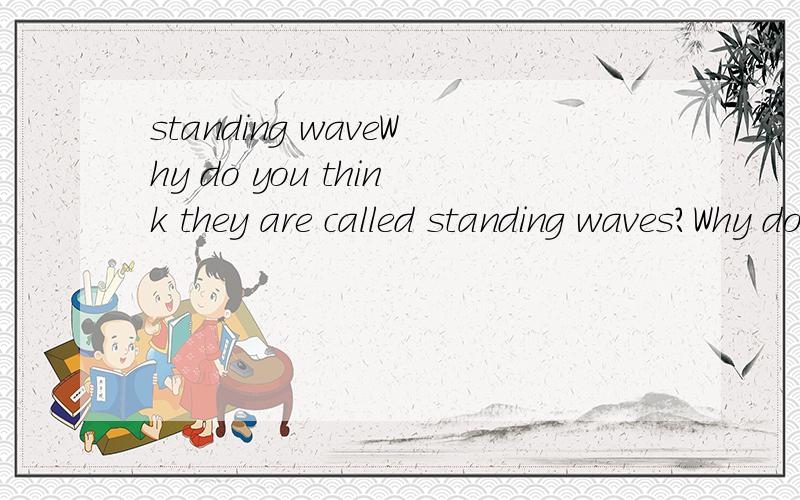standing waveWhy do you think they are called standing waves?Why do you think the standing waves are formed?
来源:学生作业帮助网 编辑:作业帮 时间:2024/11/19 04:17:31

standing waveWhy do you think they are called standing waves?Why do you think the standing waves are formed?
standing wave
Why do you think they are called standing waves?
Why do you think the standing waves are formed?
standing waveWhy do you think they are called standing waves?Why do you think the standing waves are formed?
1.Because the standing waves remain there wave forms in a constant position,looks like something standing there stationary.
2.They are often formed as a result of interference between two waves travelling in opposite directions.
standing waves 驻波
你给的东西不太全,为什么叫驻波?应该还有个图形之类的东西吧。
驻波之所以叫驻波是因为驻波的波形图不是时间函数,是固定不变的。
驻波是怎样生成的。
频率和振幅均相同、振动方向一致、传播方向相反的两列波叠加后形成的波。波在介质中传播时其波形不断向前推进,故称行波;上述两列波叠加后波形并不向前推进,故称驻波。例如,如图所示,一弦线的一...
全部展开
standing waves 驻波
你给的东西不太全,为什么叫驻波?应该还有个图形之类的东西吧。
驻波之所以叫驻波是因为驻波的波形图不是时间函数,是固定不变的。
驻波是怎样生成的。
频率和振幅均相同、振动方向一致、传播方向相反的两列波叠加后形成的波。波在介质中传播时其波形不断向前推进,故称行波;上述两列波叠加后波形并不向前推进,故称驻波。例如,如图所示,一弦线的一端与音叉一臂相连,另一端经支点O并跨过滑轮后与一重物相连。 音叉振动后在弦线上产生一自左向右传 播 的行波,传到支点 O 后发生反射,弦线中产生一自右向左传播的反射波,当弦长接近1/2波长的整数倍时。两列波叠加后弦线上各点的位移为(设音叉振动规律为u=Acosωt) u(x,t)=2Asin(x)sin( ωt )=A(x)sin(ωt),弦线上每个固定的点均作简 谐运动,但不同点的振 幅不同,由x值决定。振幅为零的点称为波节,振幅最大处称为波腹。波节两侧的振动相位相反。相邻两波节或波腹间的距离都是半个波长。在行波中能量随波的传播而不断向前传递,其平均能流密度不为零;但驻波的平均能流密度等于零,能量只能在波节与波腹间来回运行。
测量两相邻波节间的距离就可测定波长。各种乐器,包括弦乐器、管乐器和打击乐器,都是由于产生驻波而发声。为得到最强的驻波, 弦或管内空气柱的长度L必须等于半波长的整数倍,即,k为整数,λ为波长 。因而弦或管中能存在的驻波波长为,相应的振动频率为,υ为波速。k=1时,,称为基频,除基频外,还可存在频率为kn1的倍频。
入射波(推进波)与反射波相互干扰而形成的波形不再推进(仅波腹上、下振动,波节不移动)的波浪,称驻波。驻波多发生在海岸陡壁或直立式水工建筑物前面。紧靠陡壁附近的海水面随时间虽作周期性升降,海水呈往复流动,但并不向前传播,水面基本上是水平的,这就是由于受岸壁的限制使入射波与反射波相互干扰而形成的。波面随时间作周期性的升降,每隔半个波长就有一个波面升降幅度为最大的断面,称为波腹;当波面升降的幅度为0时的断面,称为波节。相邻两波节间的水平距离仍为半个波长,因此驻波的波面包含一系列的波腹和波节,腹节相间,波腹处的波面的高低虽有周期性变化,但此断面的水平位置是固定的,波节的位置也是固定的。这与进行波的波峰、波谷沿水平方向移动的现象正好相反,驻波的形状不传播,故名驻波。当波面处于最高和最低位置时,质点的水平速度为零,波面的升降速度也为零;当波面处于水平位置时,流速的绝对值最大,波面的升降也最快,这是驻波运动独有的特性。
收起
1.Because the standing waves remain there wave forms in a constant position,looks like something standing there stationary.
2.They are often formed as a result of interference between two waves travelling in opposite directions.
most importantly, these two waves have the same frequency.
A standing wave, also known as a stationary wave, is a wave that remains in a constant position. This phenomenon can occur because the medium is moving in the opposite direction to the wave, or it can...
全部展开
A standing wave, also known as a stationary wave, is a wave that remains in a constant position. This phenomenon can occur because the medium is moving in the opposite direction to the wave, or it can arise in a stationary medium as a result of interference between two waves travelling in opposite directions. In the second case, for waves of equal amplitude travelling in opposing directions, there is on average no net propagation of energy.
收起